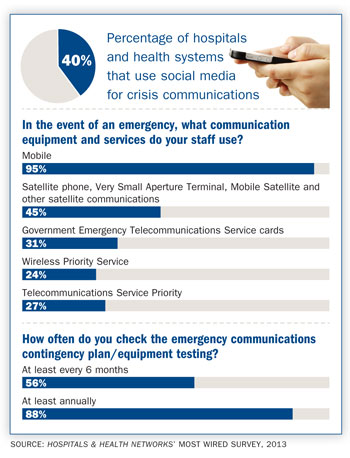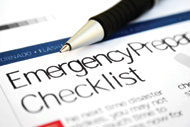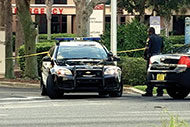 Hospitals and health care systems are gradually making social media part of their emergency response systems.
Hospitals and health care systems are gradually making social media part of their emergency response systems.
Forty percent of hospitals use social media for crisis communication, according to the 2013 Most Wired survey by Hospitals & Health Networks (H&HN), the sister magazine of Health Facilities Management. That figure is up from 32 percent in the 2012 survey.
But evidence from hospitals and health care systems that use social media as part of their emergency response along with published research touting its usefulness and potential suggest it belongs in any hospital's crisis communication toolbox.
"Clearly, social media is changing the way people communicate not only in their day-to-day lives, but also during disasters that threaten public health," states a report written by researchers from the University of Pennsylvania and published in The New England Journal of Medicine.
"Engaging with and using emerging social media may well place the emergency management community, including medical and public health professionals, in a better position to respond to disasters," the report adds.
After the Boston Marathon bombing of April 15, 2013, Michael Morrison, media relations manager, Massachusetts General Hospital, Boston, experienced the value of social media in a crisis. The hospital already had made a concerted effort to include Twitter in its disaster communication plan along with its Facebook page.
By monitoring Twitter after the bombing, the hospital learned that a rumor was being spread that Massachusetts General was in lockdown when, in fact, it was not and that the surviving bombing suspect was being brought there, also false, Morrison says. The hospital quickly corrected the misinformation, again using Twitter.
"Social media absolutely is effective and in some ways critical. It's like the old saying, ‘A lie makes it halfway around the world before the truth can put its pants on.' If there's a situation in which you need to tell people to take shelter in place or stay where they are, it's a fast, quick and effective way of doing that," he says.
Linda Reed, R.N., chief information officer at Atlantic Health System, Morristown, N.J., tells H&HN magazine that social media, such as Twitter and Facebook, plays a role in the organization's emergency response communication, but it also beefed up the system's IT-based technology after Hurricane Sandy. After Hurricane Sandy, the health care system installed a cloud-based email backup system and deployed mobile telecommuting devices for staff.
Morrison emphasizes that social media is an effective tool for emergency communication, but that other methods, such as email, still are important ways to communicate internally with staff.
Another possible incentive for hospitals to take the leap and develop a social media program is pending federal regulation involving emergency preparedness. The Centers for Medicare & Medicaid Services (CMS) proposed a rule that would require all health care providers who receive Medicare and Medicaid to establish a well-designed emergency preparedness plan.
Part of those criteria is developing alternate ways for communicating with hospital staff and all relevant emergency management agencies in case a facility's landline telephone system is inoperable.
CMS does not specify the type of alternate communication system that hospitals must have, but says viable options include cellular phones, pagers and satellite communication systems.
Other recommendations include emergency communication services such as the Government Emergency Telecommunications Service, Telecommunications Service Priority program and Wireless Priority Service, which the survey shows [see charts] are already utilized by some hospitals during an emergency.
Researchers write in The New England Journal of Medicine that "social media cannot and should not supersede current approaches to disaster management communication or replace our public health infrastructure." It acknowledges that there are hurdles involving its availability to at-risk members of the population and the need to ensure the factuality of messages.
But it also says that if "leveraged strategically, social media can bolster current communication systems" and encouraged health care systems to explore its potential.





